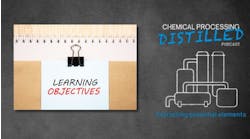[pullquote]
Chemical engineering students generally don’t get a good grounding about real-world equipment and processes while in college, as I’ve repeatedly noted — e.g., in “Young Engineers Need Our Help.” A similar lack of appreciation for actual industrial practices certainly also applies to process safety, as Trish Kerin, director of the IChemE Safety Centre (ISC), Melbourne, Australia, stressed during a presentation at the Mary Kay O’Connor Process Safety Center International Symposium in late October.
Recognizing the problem, the ISC last year issued a document “Learning Outcomes — Improve Process Safety Education in Undergraduate Engineering.” “This document does not seek to mandate how process safety should be taught nor what curricula should contain. Its contents are not accreditation guidelines, but provide guidance on industry expectations and resources available or being developed,” states the ISC.
In late summer this year, the ISC followed up by releasing a guidance document called “Sample University Laboratory Process Safety Management System.” Developed in conjunction with people from industry and academia, it presents a clever approach to expose students to process safety in practice by using existing courses involving laboratory work. “This guidance document is not a complete process safety management system, but a simplified version that is commensurate with the hazards involved at an academic institution, while still introducing process safety concepts in practice,” explains the ISC.
Using laboratory work as vehicle for increasing awareness about process safety risks and common tools to address them makes eminent sense because students can face actual safety issues in the laboratory. So, gaining a fuller understanding of such issues and how to properly identify and deal with them provides both immediate and longer-term benefits.
The 106-page document contains sections on induction and competency, e.g., culture, standards, training in equipment use, emergency response and preparation, and incident reporting requirements; risk identification and management, e.g., hazard recognition, risk assessment and identification of controls, implementation of controls, and management of change; operations, e.g., working with procedures, safe work practices, pre-startup safety review, and handover and logging; and review, e.g., detailed analysis of the success of steps taken, potential future improvements, participant learnings, etc.
Importantly, the document devotes more than three-quarters of its space to four appendices that give more than 30 examples — to provide structure, not necessarily accurate details for direct application, notes the ISC.
For instance, it includes a sample hazard observation card for a student or team to fill out for a specific laboratory project. This aims to trigger questions to identify potential safety issues and plan on how to avoid them. In addition, the appendices offer a variety of other example forms, e.g., for an incident report, management-of-change, cold-work permitting and isolation sign-off as well as sample checklists, e.g. for pre-startup safety review, and handovers.
Universities can use the whole or parts of the document, depending upon their needs, adds the ISC.
I urge engineering schools to take advantage of this document. They — and our industry — can only benefit from students with a better appreciation for process safety issues.



